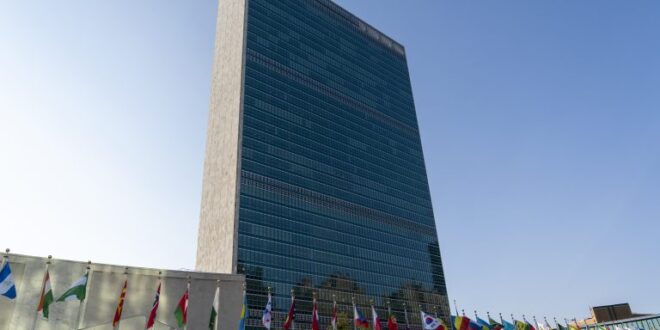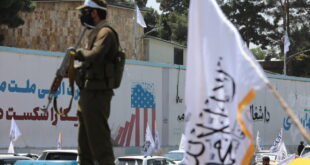Counterterrorism experts and diplomats at the United Nations are currently negotiating the biennial review of the Global Counter-Terrorism Strategy.
Although the resolution lacks the force of law, it does provide a framework for the UN and shapes the operations of nearly forty different UN funds, agencies, and programs.
This year, three critical issues confront states at the UN: repatriation, violent far-right terrorism, and ensuring the institutional architecture is fit for purpose.
2021 is an unusual year, with several negotiations allowing states a rare opportunity to reassess the UN’s institutional and operational response to international terrorism.
Counterterrorism experts and diplomats at the United Nations are currently negotiating the biennial review of the Global Counter-Terrorism Strategy (GCTS), postponed from 2020 due to COVID-19. This year, states will confront a number of complex questions, emerging against the backdrop of an unprecedented global pandemic.Although the resolution, adopted by consensus in the General Assembly, does not have the force of law, it provides a normative framework for the UN system in addressing terrorist threats and guidance that shapes the operations of nearly forty different UN entities. The original GCTS, adopted in 2006, was notable for providing some balance to what many states and experts saw as draconian Security Council action imposing binding legal obligations on all states for an indefinite period. The novelty of the GCTS was in the careful combination of measures to address conditions conducive to the spread of terrorism – the “root causes” – with more legal and law enforcement measures and a recognition that promoting and protecting human rights was in and of itself an important and worthwhile counterterrorism measure.
Over the past decade, the review process has delivered a lengthy and unwieldy document – the 2018 review (A/Res/72/284) clocked over 80 operative paragraphs – and it remains unclear whether or how states actually make use of the document. However, it is in the negotiation process itself that many of the ideological and normative battles are fought. To paint a simplistic picture, one group of states would like to see counterterrorism as a blank check for repressive measures, while another group wants to include a set of checks and balances that emphasize prevention and human rights. Still yet another group wants to prioritize the process to extract development and capacity-building support. For UN entities – including funds, agencies and programs that do have significant operations in the field – the GCTS does have operational implications, particularly in terms of guiding activities and funding. For example, it was the introduction of an emphasis on prevention, or “preventing violent extremism” (PVE), that facilitated more active engagement for several entities like UN Women or UNDP in implementing the Strategy.
States have utilized the biennial reviews to update the counterterrorism framework to include emerging challenges and political dynamics – such as a focus on measures to address Foreign Terrorist Fighters (FTFs) and an emphasis on PVE. Prevention has often been a contentious issue in UN peace and security negotiations, with several states seeing in it the possibility of mission creep and “Western imperialism.” This skepticism has colored debates on terrorism prevention efforts, which focus on addressing grievances, community engagement, and human rights. This year, three critical issues confront states at the UN: the question of repatriating foreign nationals associated with ISIS in camps in northeast Syria; the question of violent far-right extremism and terrorism; and ensuring the institutional architecture is fit for purpose as terrorist threats evolve.
The issue of repatriation has proven particularly challenging, with an unusual convergence between the United States and Russia in calling on states to take back their nationals, children in particular, for prosecution, rehabilitation, and reintegration in their own countries. European states, the U.K., and some likeminded states in other regions have adopted a strong stance against repatriation, arguing for prosecutions closer to the place where crimes were committed; however, they have made little headway in doing so due to differences over the death penalty. Moreover, several states are concerned that the evidence required to conduct effective prosecutions remains on the battlefield or in the hands of the military, contaminating the chain of evidence, and making it likely that returnees will not be held accountable. This has created an unusual fissure between traditional allies among the permanent members – France, the U.K., and the U.S., or the “P3” – and risks undermining longstanding European priorities of gender, human rights, and prevention in the GCTS negotiations.
In the Secretary-General’s (SG) regular report on implementation of the GCTS, a requirement before states begin negotiations, he has noted that, “the transnational threat from racially, ethnically or ideologically motivated individuals and groups resorting to terrorist tactics, variously described as ‘white supremacist,’ ‘far-right’ or ‘extreme right-wing,’ has also increased and that for many states in Western Europe, North America and Oceania now consider this the fastest growing or even most prominent domestic security threat they face.” There has been an increased push among several states for UN action, either via sanctions or other measures, to address such groups as it did al-Qaeda and ISIS. Several states argues that not doing so creates a double standard with only Muslim groups designated as terrorists and terrorist acts perpetrated by others considered somehow as lesser crimes. Moreover, while such groups have largely been addressed via domestic legislation and measures in their countries of origin, increased evidence of transnational linkages has increased calls for a comprehensive UN response. The SG has asked that states first condemn such violence by name – but the UN can do more than condemn. It can inform legal and criminal justice responses, build capacity, and support states by providing guidance and good practices.
Finally, this is an unusual year with multiple UN negotiations converging due to the pandemic. Such timing allows states a rare opportunity to reassess the UN’s institutional and operational response to international terrorism, nearly twenty years following the attacks of September 11, 2001, ten years after the death of Osama bin Laden, and the same year as the U.S. withdrawal from Afghanistan. During the review of the GCTS in the General Assembly, states will also have to determine whether the UN Office of Counter-Terrorism receives increased UN budgetary assistance, or remains dependent upon voluntary extra-budgetary donations. States are likely to be increasingly conservative about expanding the UN’s budget in the current climate. However, the status quo process means that the program of work is not necessarily determined by counterterrorism assessments and needs, but rather by donor preferences and politics. Following this, the Security Council will have to determine the mandates of two important expert bodies – the al-Qaeda/ISIS Sanctions Monitoring Team and the Counter-Terrorism Executive Directorate (CTED). These are also critical opportunities to think about the political, operational, and substantive directions for these bodies, and consider a closer integration of efforts with the UN Office of Drugs and Crime, and its Terrorism Prevention Branch, in Vienna. However, given the evolution of terrorist threats, overstretched budgets and resources in states’ capitals, and the return of great power competition, states will need to determine if the UN is fit for purpose for the terrorism landscape; this will necessarily include ensuring that is resourced to facilitate its effectiveness and responsiveness in this current operating environment.
 Eurasia Press & News
Eurasia Press & News




